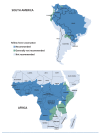Travel medicine and vaccines for HIV-infected travelers
- PMID: 22954612
- PMCID: PMC6148944
Travel medicine and vaccines for HIV-infected travelers
Abstract
For the purposes of vaccination, persons with asymptomatic HIV infection and CD4+ cell counts of 200/μL to 500/μL are considered to have limited immune deficits and are generally candidates for immunization. HIVinfected persons with CD4+ cell counts less than 200/μL or history of an AIDS-defining illness should not receive live-attenuated viral or bacterial vaccines because of the risk of serious systemic disease and suboptimal response to vaccination. Available data indicate that immunization during antiretroviral therapy restores vaccine immunogenicity, improves the rate and persistence of immune responses, and reduces risk of vaccine-related adverse events, although vaccine responses often are suboptimal. Major issues for travelers to the developing world are vaccine-preventable illnesses (hepatitis A virus, yellow fever, and typhoid fever), traveler's diarrhea, and malaria. This article summarizes a presentation by D. Scott Smith, MD, at the IAS-USA continuing medical education program held in San Francisco in April 2012.
Conflict of interest statement
Financial Disclosure: Dr Smith has no relevant financial affiliations to disclose. (Updated 8/13/12)
Figures


Similar articles
-
Travel to Brazil: analysis of data from the Boston Area Travel Medicine Network (BATMN) and relevance to travelers attending world cup and olympics.J Travel Med. 2014 May-Jun;21(3):214-7. doi: 10.1111/jtm.12117. Epub 2014 Mar 28. J Travel Med. 2014. PMID: 24673916 Free PMC article.
-
Risks of travel, benefits of a specialist consult.Cleve Clin J Med. 2010 Apr;77(4):246-54. doi: 10.3949/ccjm.77a.09097. Cleve Clin J Med. 2010. PMID: 20360118 Review.
-
Current immunizations for travel.Curr Opin Infect Dis. 2003 Oct;16(5):369-74. doi: 10.1097/00001432-200310000-00001. Curr Opin Infect Dis. 2003. PMID: 14501987 Review.
-
Safety and immunogenicity of typhoid fever and yellow fever vaccines when administered concomitantly with quadrivalent meningococcal ACWY glycoconjugate vaccine in healthy adults.J Travel Med. 2015 Jan-Feb;22(1):48-56. doi: 10.1111/jtm.12164. Epub 2014 Oct 13. J Travel Med. 2015. PMID: 25308927 Clinical Trial.
-
Vaccination for safe travel to India.Hum Vaccin Immunother. 2014;10(4):1111-3. doi: 10.4161/hv.27234. Epub 2013 Nov 27. Hum Vaccin Immunother. 2014. PMID: 24284411 Free PMC article.
Cited by
-
Infection prevention in the immunocompromised traveler due to conditions other than transplantation: a review.Ther Adv Infect Dis. 2025 Jan 23;12:20499361251313827. doi: 10.1177/20499361251313827. eCollection 2025 Jan-Dec. Ther Adv Infect Dis. 2025. PMID: 39866828 Free PMC article. Review.
-
Vaccinations for the HIV-Infected Adult: A Review of the Current Recommendations, Part II.Infect Dis Ther. 2017 Sep;6(3):333-361. doi: 10.1007/s40121-017-0165-y. Epub 2017 Aug 5. Infect Dis Ther. 2017. PMID: 28780736 Free PMC article. Review.
-
Prospects for dengue vaccines for travelers.Clin Exp Vaccine Res. 2016 Jul;5(2):89-100. doi: 10.7774/cevr.2016.5.2.89. Epub 2016 Jul 29. Clin Exp Vaccine Res. 2016. PMID: 27489798 Free PMC article. Review.
References
-
- Freedman DO, Weld LH, Kozarsky PE, et al. Spectrum of disease and relation to place of exposure among ill returned travelers. N Engl J Med. 2006;354(2):119-130. - PubMed
-
- Centers for Disease Control and Prevention (CDC). Immunocompromised travelers: approach to the immunocompromised traveler. http://wwwnc.cdc.gov/travel/yellowbook/2012/chapter-8-advising-travelers.... Accessed July 18, 2012.
-
- Weissman S, Feucht C, Moore BA. Response to hepatitis A vaccine in HIV-positive patients. J Viral Hepat. 2006;13(2):81-86. - PubMed
-
- Centers for Disease Control and Prevention (CDC). Yellow Book: Yellow Fever Vaccine Maps. http://wwwnc.cdc.gov/travel/yellowbook/2012/chapter-3-infectious-disease.... Accessed August 1, 2012.
-
- Pacanowski J, Lacombe K, Campa P, et al. Plasma HIV-RNA is the key determinant of long-term antibody persistence after Yellow fever immunization in a cohort of 364 HIV-infected patients. JAIDS. 2012;59(4):360-367. - PubMed
Publication types
MeSH terms
Substances
LinkOut - more resources
Full Text Sources
Medical
Research Materials
Miscellaneous
